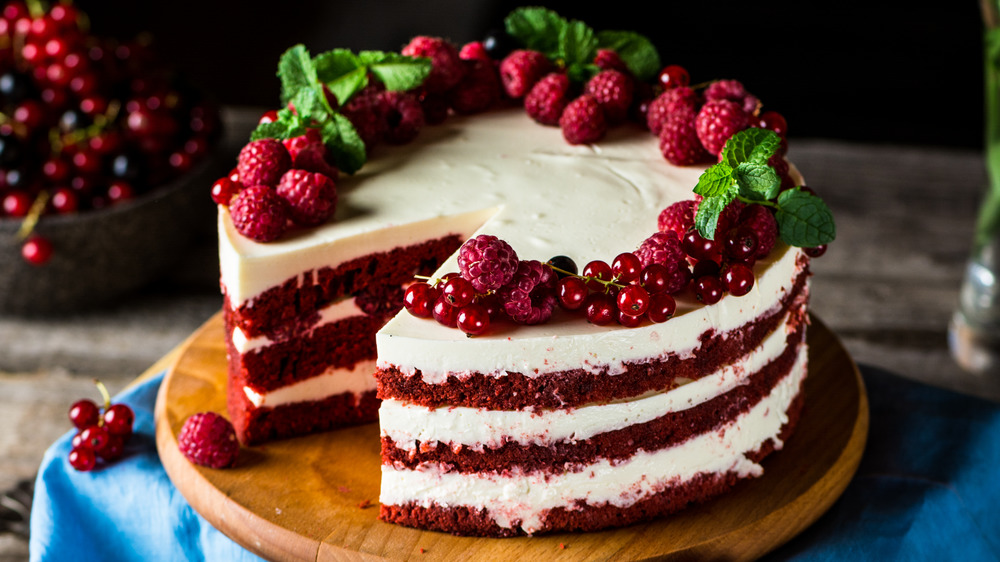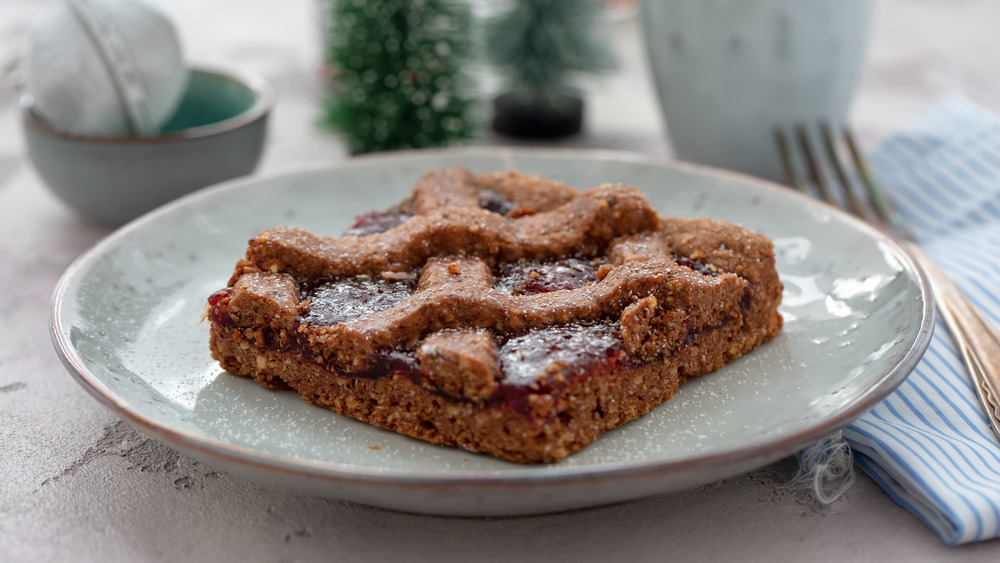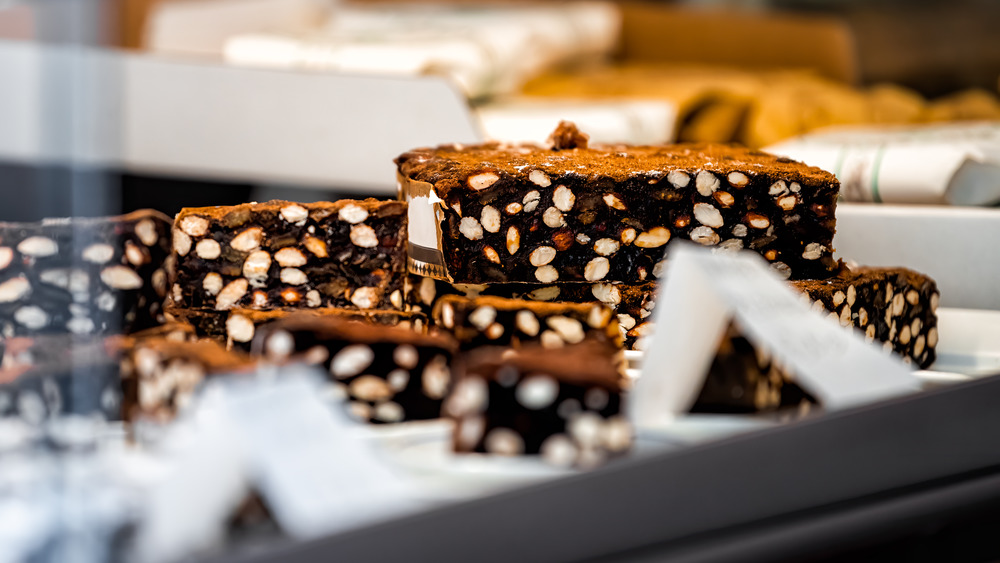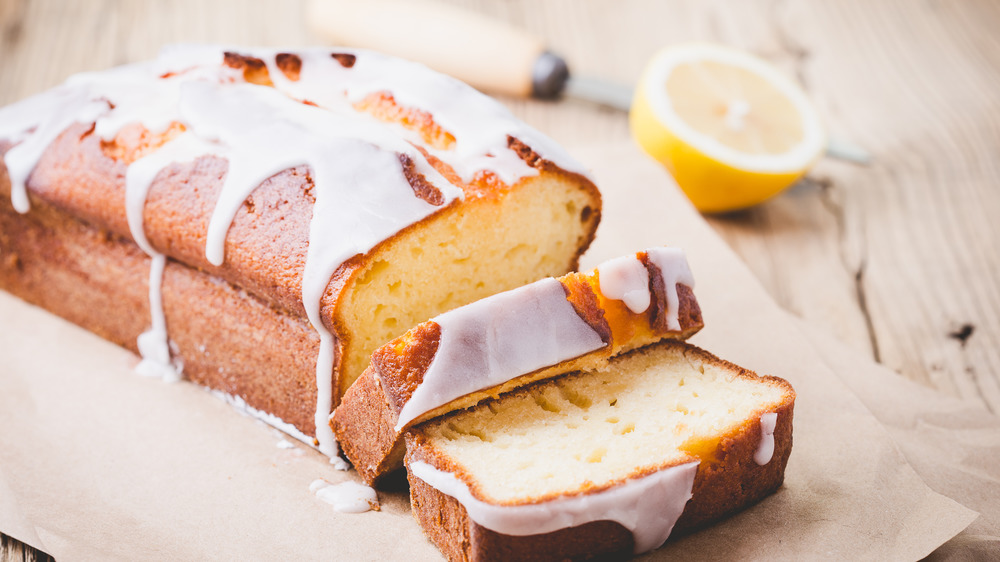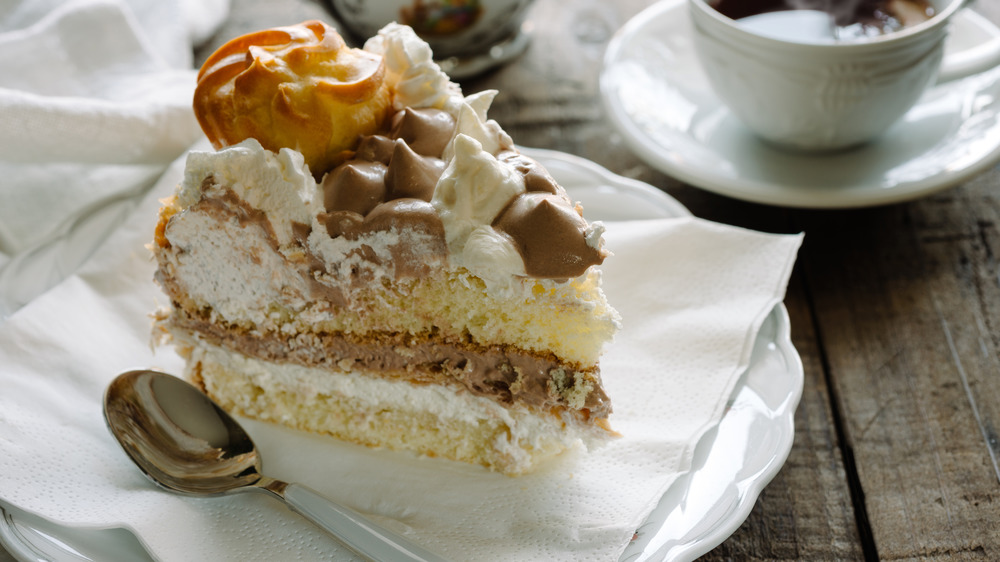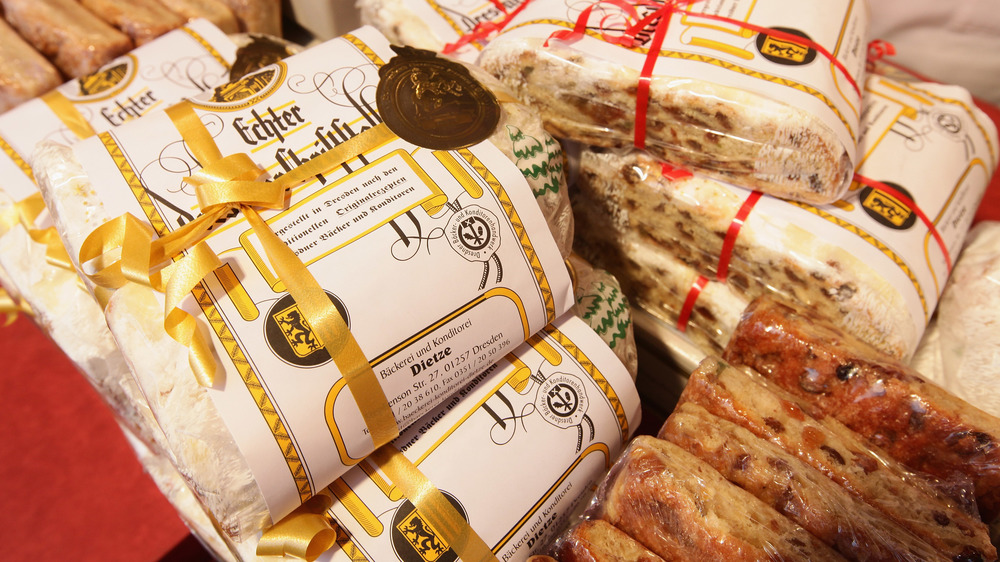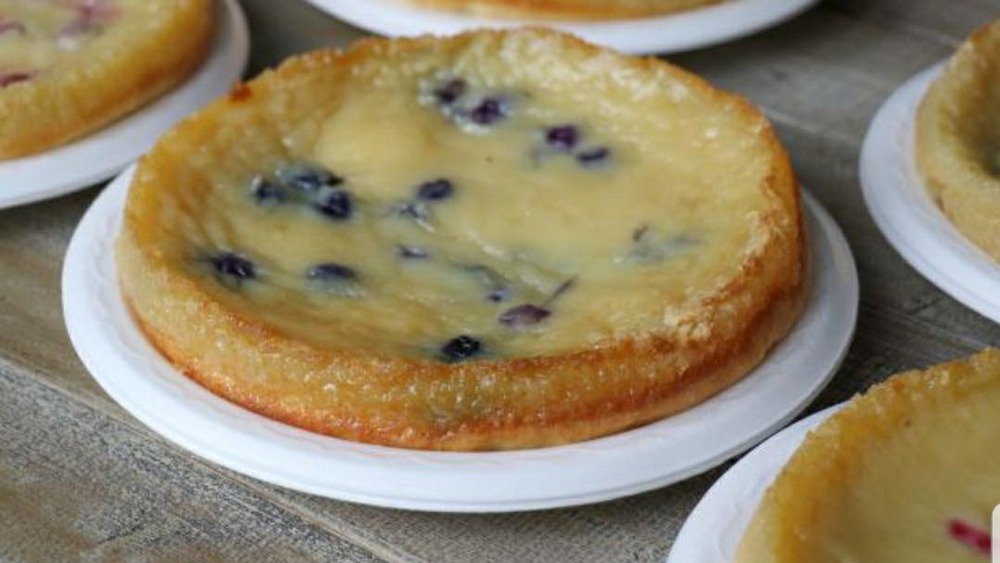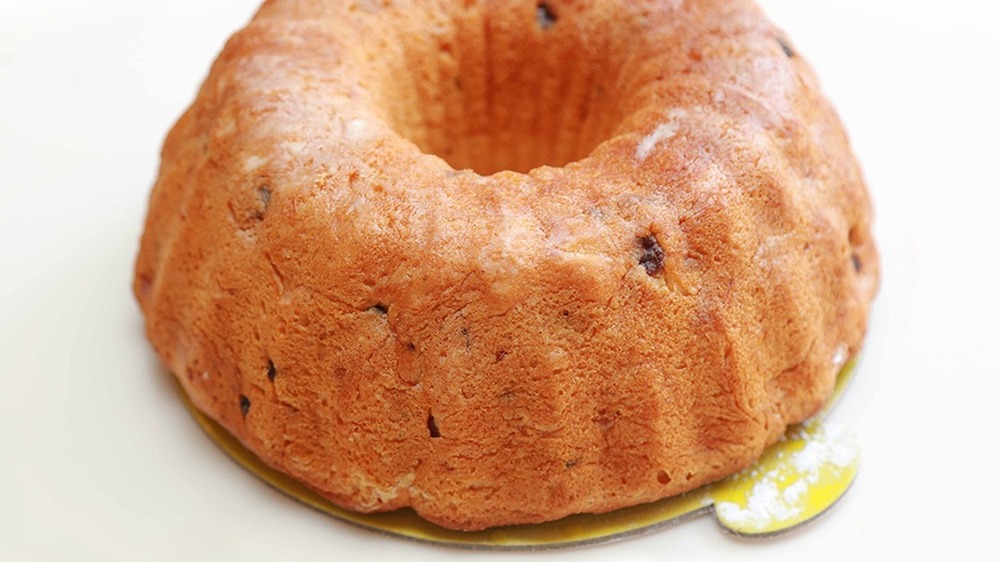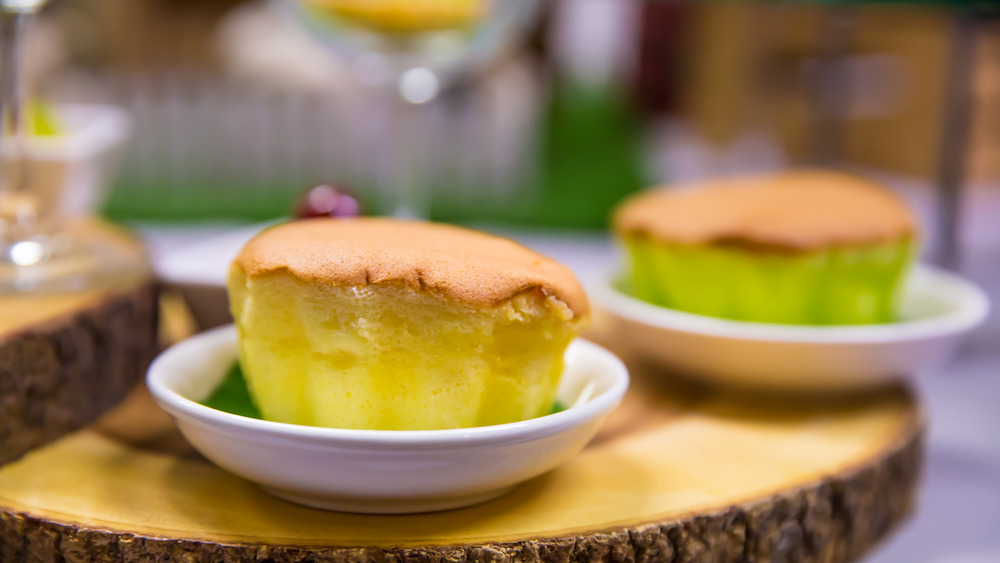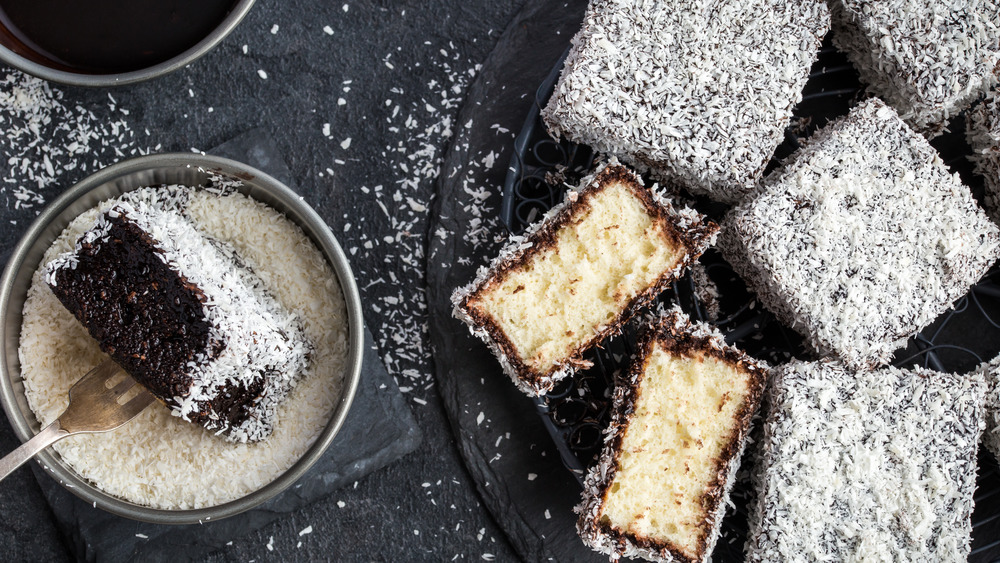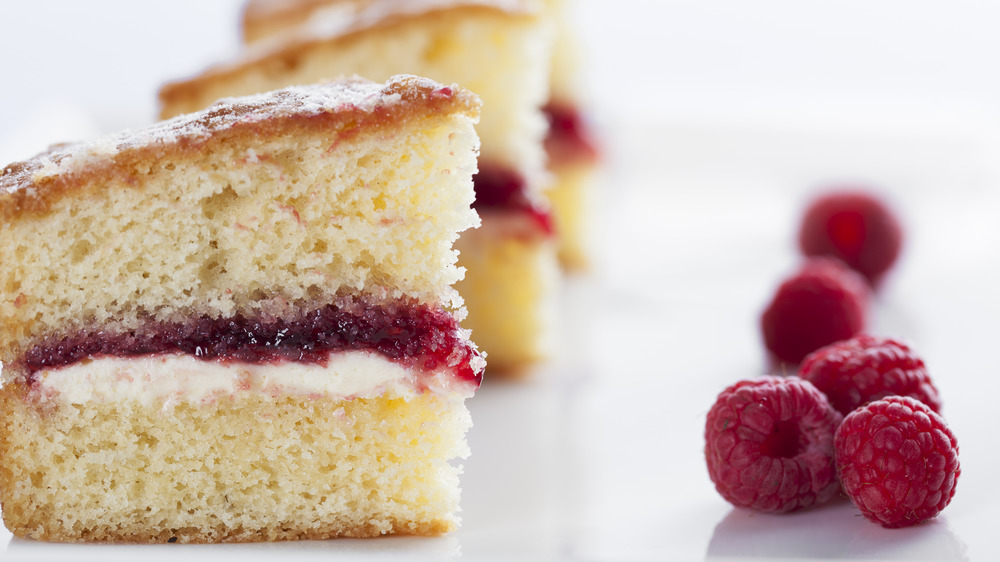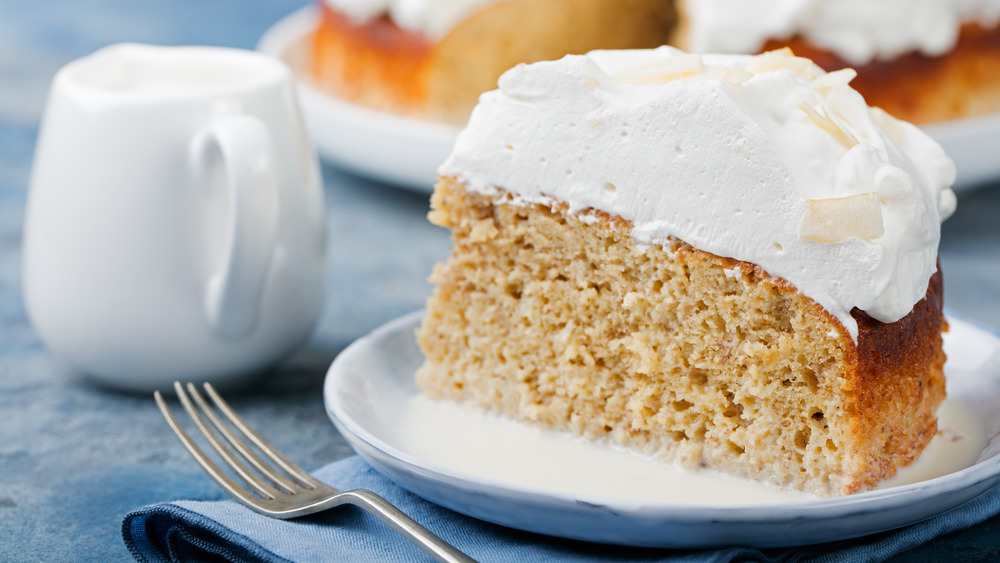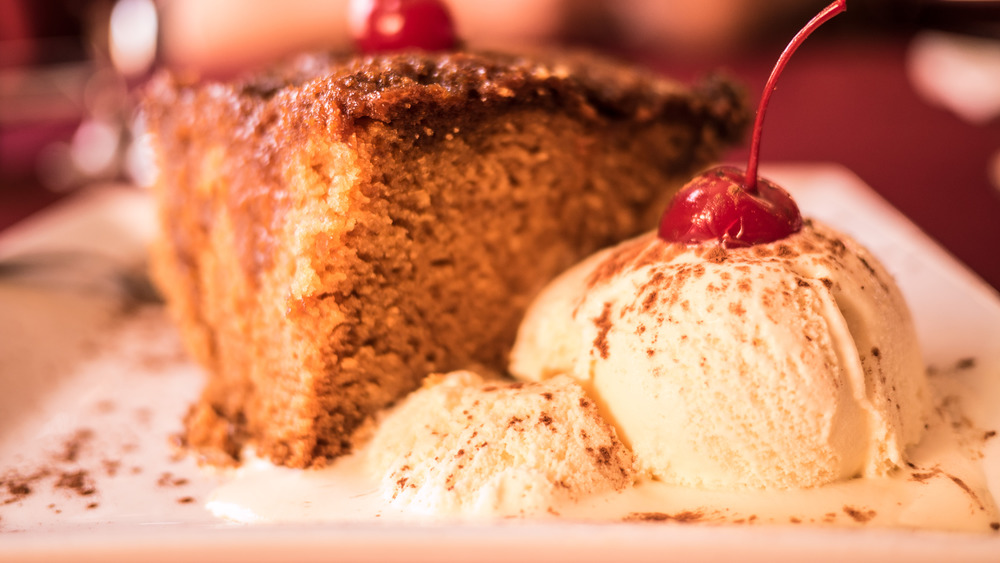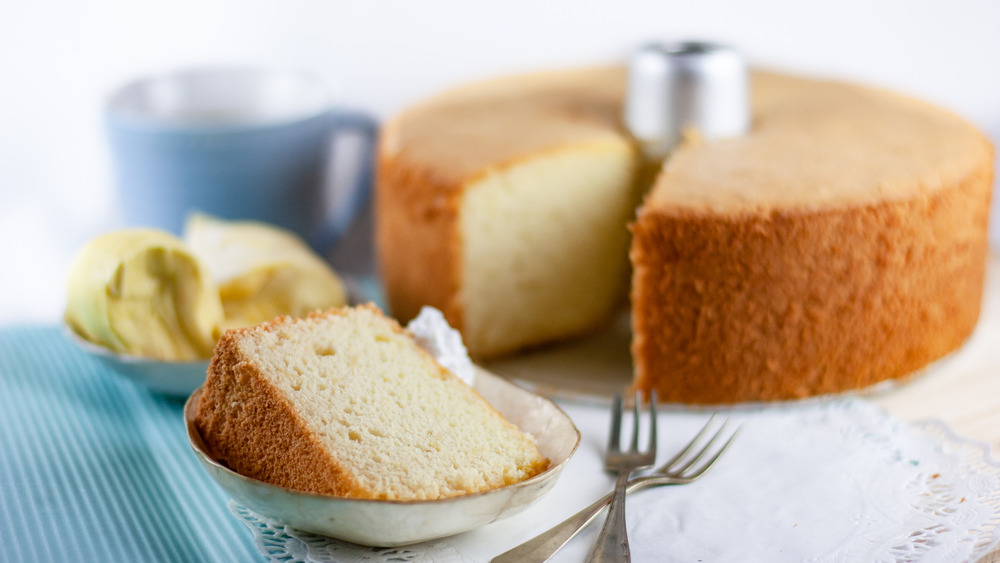The Most Traditional Cakes From Around The World
Everyone loves a good cake — and it's easy to see why. After all, cake comes in a variety of flavors, shapes, sizes, temperatures, etc. Birthday cake, ice cream cake, dirt cake, sheet cake, pineapple upside down cake, the much-debated fruit cake — whatever your preferences when it comes to baked goods, it's likely you can find a cake that you'll love and defend until the day you die.
But the cakes most of us eat today, regardless of the holiday or any ol' reason, often aren't true to cake's origins. According to one article from Bon Appetit, the word "cake" originally meant generally any lump of cooked dough. It wouldn't be until the 1400s that cake took on a form more similar to what we see today, with cakes with a sweeter taste. Things would become even more familiar to the modern diner in the 1700s, when colonialism and sugar cane farming brought sugar in large quantities to Europe and frosted cakes were introduced.
From there, nearly every culture in the world has developed its own traditional cakes, using the resources at hand and the favorited flavors and ingredients of their regions to create sweet treats that have become beloved by foodies near and far.
Interested in seeking out and trying (or baking) some of the world's most traditional cakes? Here are 14 that deserve your attention.
The linzer cake claims to be the oldest cake in the world
According to the Austrian tourism board, the linzer cake, also called a linzer torte, is supposedly the oldest cake in the world, at least by today's standards of what a cake is and should look and taste like.
Named after Linz, Austria, the cake's roots can be traced back to the 1600s, with recipes still around from that era that call for butter, almonds, sugar, flour, and spices popular in the day. Today, the linzer torte often features a shortcake pastry and red currant jam and is served with whipped cream or confectioners' sugar.
Of course, the argument could be made that the linzer cake isn't really a cake at all, but is rather a torte, which is technically a variation of a cake that, if you want to split hairs, is more similar to a tart or a pie. Whatever your opinion, if you want to go traditional, you can't go wrong with the so-called oldest cake in the world.
Meanwhile, the castella could actually be the oldest cake in the world
Is a cake rivalry in the works? While Austria holds fast to the idea that the linzer cake/torte is the oldest cake in the world, some say that the title belongs to the castella cake, a Japanese specialty. It reached Japanese shores in the 1500s, making its way to Asia via Portuguese missionaries — though the castella cake had yet to reach its final form that visitors to Japan will see today.
According to the Nippon Communications Foundation, the castella in its earlier form was brought to Japan by Portuguese missionaries in the 1500s. Even then, though, the missionaries knew they had something special on their hands, doling out castella cakes to prospective converts and the ill. Japanese travelers and locals liked the cake so much that they kept it for themselves.
Regardless of when or how the castella came about, there's no denying that this traditional cake is delicious. Historic castella shops can be found throughout Nagasaki that dating back to the 1800s, and castella shops have even been making their way into neighboring countries in order to meet regional demand.
Traditionally, castella cake is made with eggs, flour, a starch syrup, and sugar, resulting in a spongy texture with a crunchy sugar coating on the bottom.
And you can't overlook this Italian cake with 13th-century roots
Additionally, if you really want to get picky when it comes to oldest cake in the world, you can't overlook panforte. The holiday cake is similar to a fruit cake, with a strong, spice-filled flavor and just enough substance to hold the myriad of ingredients together.
Legend states that a nun in Siena, Italy, created panforte in the 13th century, using sugar, spices, almonds, and honey. Others agree with the timeline but state that the evidence for the cake's origins are a bit more tangible, with parchments from the 1200s indicating that the local nuns required a similar cake, made with pepper and honey, as a type of tax.
Now, you can find panforte all over Italy and across the world, as its fame has spread. There are a few different types of panforte available, including a chocolate variety, a more bitter variety made with bitter almonds, and a lighter variety dusted with confectioners' sugar.
This cake is so straightforward and simple that cultures around the world lay claim to it
When it comes to "oldest cake in the world" status, the pound cake could be a solid contender. This simple, straight-forward, still-widely-popular-today cake has been favorited all over the world for centuries. After all, it doesn't take a genius to figure out that you can make a great cake with just a few ingredients and an easy formula, and so that's exactly what innovative chefs did the world-over, all around the same time.
Originally made with one pound each of butter, sugar, eggs, and flour, the recipe was easy to remember for those who could not read or write, and the large quantity of ingredients resulted in a cake that would be large enough to feed a family or multiple guests.
Recipes for pound cakes have been found in cookbooks dating back to the 1700s, both in Great Britain and in the United States. Similarly, the French quatre-quart (or four fourths) is the same basic formula of one part butter, one part sugar, one part eggs, and one part flour.
If you've yet to try or make a pound cake, this is one traditional cake to add to your list.
This saintly cake gets holy approval
As with the panforte, some cakes just have holier ties, but none is quite as holy as the St. Honore Cake, a.k.a. the cake that's literally named after the patron saint of bakers. Developed in the 1800s, this French cake is one that will test your baking and pastry prowess. NPR calls it a "'master class confection,' because it contains all of the fundamental elements that pastry school students need to conquer in one package: puff pastry, pâte á choux, pastry cream, and caramelized sugar."
If you choose to purchase rather than bake your St. Honore cake, you'll discover a pastry disk filled with Chiboust cream and topped with cream puffs, capped with caramelized sugar and whipped cream, all flavored with vanilla (though specialty flavors like green tea and fruit flavors are also available).
The Feast of St. Honore takes place on May 16, and it's the perfect occasion for you to try your hand at making this traditional cake — or to hunt it down at your nearest classical French bakery or patisserie.
The stollen cake is possibly the most serious cake in the world
While it may not exactly have a holy origin story, the stollen cake certainly takes a near-righteous spot in the minds of its protectors, the Dresdner Stollen Association of Dresden, Germany. The association was formed in 1991 to "protect Dresdner Christstollen ... and protect its geographical indication, the result of which are the golden stollen seal and the EU quality label." In other words, the association is very serious in defending and maintaining the identity of what a stollen cake is and where you can find a traditional stollen. According to the association, Dresden Christstollen can only be produced in a certain geographic area and only with certain approved ingredients.
If you want to make your own stollen at home, though, we won't tell. The fruit cake-like treat is essentially a yeasty cake loaf made with fruits, orange juice or rum, marzipan, toasted almonds, and a blend of flavorful spices such as cardamom and mace.
The kuchen, on the other hand, is a German cake that's strayed far from home
The kuchen (the "ch" is pronounced like a "k") is the German word for "cake," but this traditional cake has made its way far, far from home. Traveling along with Germans wherever they happened to settle, kuchen still finds a top spot on families' tables throughout Latin America and the United States.
According to the Farmers Almanac, which gave kuchen a nod as the official state dessert of South Dakota, traditional German-style kuchen features a plain dough, possibly with oats or yeast added, and then a variety of toppings, including seasonal fruits and/or a simple, unsweetened custard.
Kuchen is traditionally enjoyed alongside a cup of coffee during an afternoon break. You can, of course, make your own kuchen, but if you ever make a stop in South Dakota, you may just find it in just about every grocery store and bakery, as well as at every seasonal festival.
A remnant of colonialism, this cake took off in an unlikely place
Another cake that really grew in popularity once it left its home country, breudhur is a traditionally Dutch cake that, due to Dutch colonialism, made its way to Southeast Asia. Now, the breakfast-style and holiday cake is eaten all across the region, including Indonesia, Sri Lanka, Singapore, and Malaysia.
"Breudher is a gastronomic memoir of the rich and pompous colonial past," says one article in Route Cochin. "Breudher has a distinct flavor and a tantalizing aroma. The Anglo-Indians call it the Dutch cake."
Buttery and made in a fluted mold (like a bundt pan), breudhur takes on subtle differences depending on where you are in Southeast Asia and what ingredients are available, but generally you can always count on the cake to be made with a mix of flour, yeast, eggs, butter or ghee, sugar, and raisins. Extra flavors you might find include cinnamon and nutmeg or orange zest.
Mamon is a Filipino cake with World War II origins
A traditional, popular cake with more recent origins, mamon came about during World War II, another culinary remnant of foreign involvement. According to an article in The Bangkok Post, World War II rations forced bakers to become inventive, combining flour and butter together into a subpar cake. The cake has been refined since and is now a sweet, buttery, light, and small treat that can be found all over South Asia, in a variety of flavors, for an affordable price.
"Mamon could very well be the face of Filipino cuisine, as this sponge cake has become a versatile treat that can be snacked on at any time of the day, mainly because of its affordable price," says the same Bangkok Post piece.
Today, you can find traditional mamon cakes at Filipino bakery chain Goldilocks, with its locations in the United States, Canada, and Asia. The chain is credited with helping to popularize the more refined version of the cake both at home and abroad.
Australia's favorite cake was originally meant to feed unexpected government guests
With Australians calling lamingtons "the most Australian cake," if you're taking your taste buds on a world trip via the most traditional cakes, you can't miss this spongey, chocolate-dipped confection.
First enjoyed in the early 1900s, it's said that Lord Lamington's, Queensland's governor at the time, chef created the lamington cake to have on hand to feed unexpected visitors. Those visitors would certainly be in for a treat, too, with this soft and buttery cake coated in chocolate and coconut. Now, Australians often enjoy lamingtons on Australia Day.
For making the perfect lamingtons at home, ABC Life recommends starting with a fresh, fluffy sponge cake made with fresh eggs. Then, coat the individual, cut cakes (lamingtons are on the smaller side) with a thick chocolate that's not so hot that it runs off your cake, and sift your coconut over the cake for a fine dusting. And, as the article says, feel free to get creative with exciting colors and flavors.
You've seen it numerous times on GBBO — now it's time to try it for yourself
Another traditional cake that got its start in a government setting, the Victoria Sponge is now known as a classic the world over (partially thanks to the Great British Bake Off). According to What's Cooking America, the two-layer sponge cake filled with jam and cream and cut into small squares became a favorite with the advent of British tea time. One of Queen Victoria's ladies-in-waiting brought afternoon tea time to court, Queen Victoria latched on to the idea, and the Victoria Sponge was featured.
The English Heritage organization clarifies that the Victoria Sponge could have gotten its actual start in nurseries, however, as caregivers thought it unwise to give children cakes that contained fruit or seed pieces. Since the Victoria Sponge contains neither, it was a child's treat before it found its way to the adults of the household.
Of course, the development of the light and airy Victoria Sponge could also be connected to the development of baking powder, which first came about as a leavening agent right around the same time, in the mid-1800s, and which certainly would have made the process easier.
This traditional cake comes with a side of mysterious origins
Some cakes that have acquired traditional status today aren't really that old at all. Take, for example, the tres leches cake, which is resolutely cemented within Latin cuisine. The decadent sponge cake soaked in three milks and slathered with a thick topping has been a part of Latin menus for so long that one might assume it's a centuries-old cake with a storied past.
However, while multiple countries throughout Latin America claim to have first presented the world with tres leches cake, the fact still remains that there's not a huge amount of historical information on the advent of tres leches cake. It makes sense in many ways that tres leches cake wouldn't become widespread until the advent of canned milk in the late 19th century, which would make it more convenient to access the cake's required evaporated, condensed, and whole milks.
Food writer Julia Gartland puts several theories forth in a Food52 article, including the possibility that tres leches cake started as a soaked Middle Ages cake in England and was then brought to Latin America by European colonizers.
Regardless of where it comes from, though, one thing's for sure: Tres leches cake is a delicious traditional dessert deserving a spot among any baker's favorite recipes.
This South African cake gained traditional status in the span of just a few decades
Malva pudding isn't really a pudding at all, at least not how Americans think of pudding. Instead, it's a cake — buttery and sugary, with apricot jam and covered in a hot cream sauce. Malva pudding appears on many a dessert menu at South African restaurants around the world and is rumored to have been one of Nelson Mandela's favorite desserts, but despite its spot as a traditional cake, it's not really that old. In fact, it might be less than 50 years old.
According to a Food52 article, South Africa's malva pudding only goes back to 1978 when a local woman gave her pudding recipe to a winery restaurant and then that restaurant passed the recipe around to several other restaurants in the country.
"In malva pudding's middle age, it's already achieved the rank of 'classic.' ... Was it always poised for icon status? Could the explanation be as simple as the fact that, from a small ingredient list and a simple technique, you get a dessert that is comforting almost to the point of smothering?" asks food writer Sarah Jampel in the article. The answer, the article concludes, could just simply be in how easy it is to make malva pudding.
Cake traditions continue to evolve with this relative newcomer on the U.S. culinary scene
Just like South Africa's malva pudding, new additions to the traditional cake ranks pop up every so often. One to ruffle Americans' feathers was the chiffon cake, which first appeared in 1927 and was instantly called "the first new cake in 100 years" — whether or not that's actually the case.
According to What's Cooking America, a Los Angeles insurance agent invented the cake, making it for Hollywood stars of the day, until General Mills bought the recipe and published it in Better Homes and Gardens, along with that "first new cake in 100 years" claim. An instant success, home cooks loved the light and airy chiffon cake, which gets its unique texture from egg whites beaten separately from the batter and vegetable oil. Similar to angel food cake, chiffon cake has a slightly richer flavor and a more crumbly texture.
Now, nearly 100 years after its invention, you can find chiffon cakes in a variety of flavors, from lemon to pandan, with a variety of toppings.
